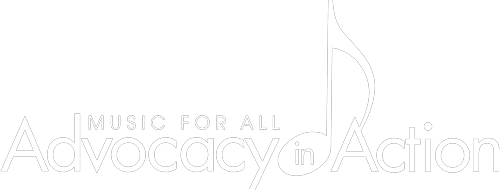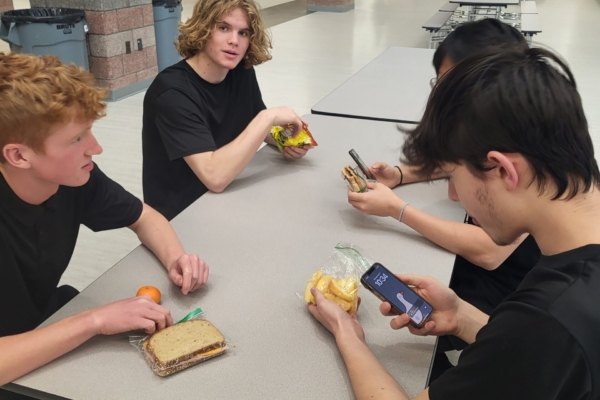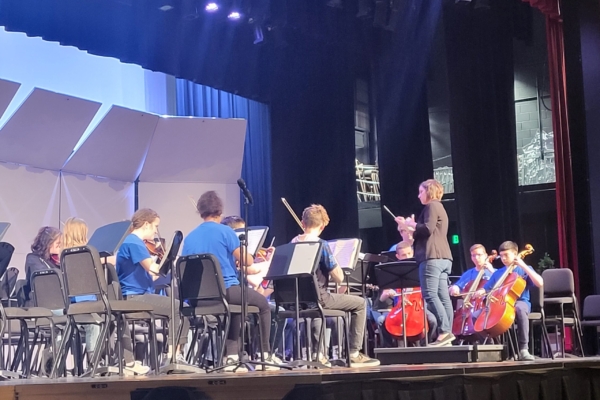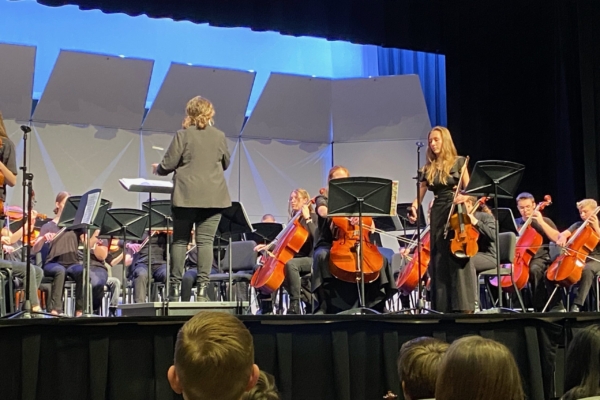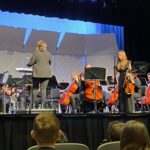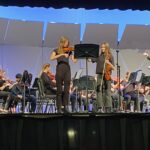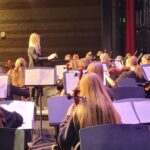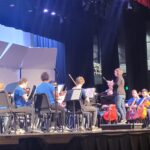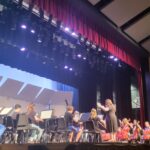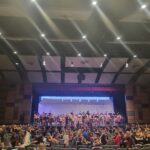“East Zion Orchestra Festival”
Washington County School District Orchestras
St. George, UT
Description
900 students gather to perform in a non-adjudicated festival in a fun, and relaxed environment. It is designed to teach students how to support one-another regardless of the rivalry that might exist between schools. The program opens up the string world past their classroom borders and allows students to see others that are just like them.
Students are given the opportunity to listen to music at their level, comment about it, and cheer for those performing. At the end, all students perform one piece, creating a 900 piece orchestra! They create new friendships and long-lasting bonds with each other.
Objectives
Objective 1: Students are exposed to other students that play their instrument.
Students not only hear and see other students their ages perform, but they are encouraged to cheer and support each group on stage. In the final piece, students with shoulder instruments play together in the audience chairs while basses and celli play on stage, intermixed with multiple schools.
Objective 2: Students are given the opportunity to listen to, cheer for, and mingle with students from schools they might otherwise see as rivals.
The event is informal. Students wear school t-shirts or identifying school apparel. Students are led by teachers in cheering and encouraging each group on stage. In addition, students eat lunch together as a way to foster cross-school relationships.
Objective 3: Students will prepare a multi-level piece of music which they will perform together in a Mega-Orchestra.
All teachers prepare a previously chosen, multi-level piece with their students. After every group has performed for each other, the teachers spread out across the auditorium and on stage to conduct the mass group in performing the piece together. It is a powerful way to promote the idea that “we are one” in the music community.
Objective 4: Students will find joy and excitement in the event, which will help them in making decisions to register for orchestra in the upcoming year.
The event take place before registration and teachers refer back to the event as part of the registration process.
Objective 5: Teachers will model collaboration and demonstrate what it looks like to work together without amnesty or rivalry within our district boundaries.
This program is designed to keep students in orchestra and to help them look beyond boundaries. Students are asked to follow the lead of the teachers in working together and showing mutual respect and kindness.
Target Audience
6th-9th grade students are the target audience.
Our district starts orchestra in 6th grade. Students are vulnerable to a lot of outside voices during this time. Peer pressure, the offerings of other electives, and a multitude of other distractions keep students away from registering for the next year. We want to give our students fun things to look forward to that will help them see and feel the joy of performance.
These age groups are also susceptible to extreme feeling of hate or anger towards other schools. We want them to experience the feelings of comradery before they reach their high school years.
Timeline
Planning begins in August of each school year. At that time, a host school is chosen and the Multi-Level piece is chosen.
From September through December, each teacher choses their festival music and talks to the students about the “field trip festival” they will be experiencing in the Spring.
In January, the host school teacher designs the seating chart, the order in which the schools will perform, and when lunch works best for his or her school.
From January until festival, all teachers ensure their music is prepared and the Multi-Level piece is ready.
East Zion Festival falls anytime between the end of January and early March (depending on the scheduling conflicts at the host school).
Overview of Planning and Execution
Kirsten Candland – Team Leader/Participant
Stephanie Snow – Host School/Participant
Hayley Winslow – Committee Member/Participant
Amy Paterson – Committee Member/Participant
Kamille Brooks – Committee Member/Participant
Kiley Kolodziej – Committee Member/Participant
April Nielsen – Committee Member/Participant
Krystin Richardson – Committee Member/Lead Director/Participant
Jacob Nielsen – Committee Member
Will Stucki – Committee Member
Malerie Whitman – Committee Member
Lacey Young – Committee Member
Tools and Resources
We used the power of collaboration, our District Fine Arts leaders for support, our district busing system, and the support of our host high school.
Marketing and Promotion
We used email to inform parents. We invited parents to attend if they wanted to watch their children perform, however, our focus was strictly on the students and we did not promote extensively. We wanted the student experience to be our focus. We have many concerts and other community events that focus on both students and audience. We wanted this experience to be set apart from the rest.
Costs
We paid $75 for our joint music.
Each teacher bought lunch for their groups, totally about $200 per group.
Each teacher was responsible for their bus costs which differed depending on where they were traveling from. On average, teachers paid $150-$300 for travel.
Challenges/Obstacles
Our busing system is difficult to work with due to lack of drivers. We did have late buses and groups that were not on time because of this. We simply had other groups go ahead and we slid groups in as they arrived.
Scheduling so many groups with enough time to perform was HARD! However, we were able to fit everyone in by having a very organized system of lining up groups and moving one onto the stage from the audience while the other was moving off. This allowed for very little down time and only minutes between groups. Another thing that helped this situation was having us all tune together twice instead of each group tuning individually. With this being informal, it worked out quite well.
We got off in a section of the large group performance. We cut our students off, had a good laugh, and continued. It’s really a lot of fun having SO many students and SO many directors all work together at the same time! Everyone should try it!
Success/Effectiveness Measurement
We know immediately in music when things go well. We had that immediate feedback in the performances of each group. The excitement and cheering coming from the audience was a huge indication of our goal to teach unity. The mingling was a bit harder but achievable with our encouragement during the lunch break.
The largest indication of success in the larger enrollment numbers at most of our schools. We cannot “make” kids take music classes, but it is good to see our efforts help encourage them to stay.
Community Impact
Our district orchestra teacher team is a model team in our school district. Other groups are watching this event specifically and are trying to find ways to duplicate it in their own ways. It has greatly helped in developing positivity and solid relationships among the orchestra teachers.
Anything positive that happens at the district level has a trickle down affect into each school. Due to the fact that each school was so heavily involved, each school saw the benefits through enrollment, students behavior, and overall happiness in music.
Advice for others?
Don’t do this alone! If you have an uncooperative team, build those relationships before trying to make this work. If you have 1, 2, or 3 other teachers on board, start there. If you have a small district, invite another district to work with you. Don’t force it, grow it.
